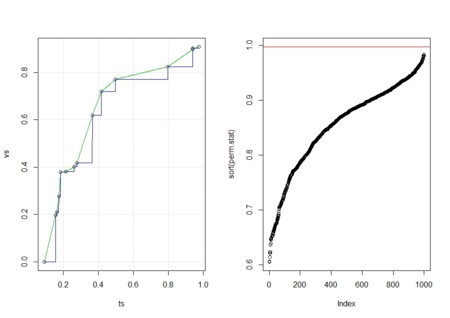- 2つの関数関係を表すものに相関関数がある
- 内積の拡張であるという(こちら)
- 2つの有限長のベクトルの内積を、有限長のベクトルの長さの平方根の積で割ると、2つのベクトルのなす角のコサインになる
- 相関関数の場合も、2つの関数の相関関数を、それぞれの関数の自己相関関数(ずれのないときの)の平方根で割ってやれば、関数の「角のコサイン」のようなものが出るはず
- Rでやってみる

Np<-15
ts<-sort(runif(Np))
vs<-sort(runif(Np))
vs<-vs-min(vs)
library(pracma)
ss<-seq(from=0, to=1,length=1000)
ss<-ss[which(ss>(min(ts)) & ss< max(ts))]
yc<-interp1(ts,vs,ss,method="constant")
yl<-interp1(ts,vs,ss,method="linear")
yn<-interp1(ts,vs,ss,method="nearest")
ys<-interp1(ts,vs,ss,method="spline")
ys<-interp1(ts,vs,ss,method="cubic")
plot(ts,vs)
grid()
lines(ss,yc,col=2)
lines(ss,yl,col=3)
lines(ss,yn,col=4)
lines(ss,ys,col=5)
lines(ss,yc,col=6)
my.convolve<-function(x,y,type="open"){
i.p<-(convolve(x,y,type=type))
x.x<-max(convolve(x,x,type=type))
y.y<-max(convolve(y,y,type=type))
return(list(corr=max(i.p)/sqrt(x.x[1]*y.y[1]),vs=i.p/sqrt(x.x[1]*y.y[1])))
}
Niter<-1000
ori<-my.convolve(yc,yl)$corr
perm.stat<-rep(0,Niter)
reserve.vs<-vs
for(i in 1:Niter){
tmpvs<-sample(vs)
plot(ts,tmpvs)
tmpyc<-interp1(ts,tmpvs,ss,method="constant")
lines(ss,tmpyc,col=2)
lines(ss,yl,col=3)
perm.stat[i]<-my.convolve(tmpyc,yl)$corr
if(perm.stat[i]==max(perm.stat,ori)){
reserve.vs<-tmpvs
}
}
par(mfcol=c(1,2))
plot(ts,vs)
grid()
tmpyc<-interp1(ts,reserve.vs,ss,method="constant")
lines(ss,tmpyc,col=2)
lines(ss,yl,col=3)
lines(ss,yc,col=4)
plot(sort(perm.stat),ylim=range(c(ori,perm.stat)))
abline(h=ori,col=2)
par(mfcol=c(1,1))
